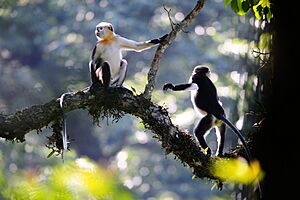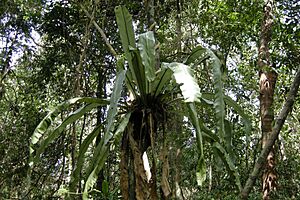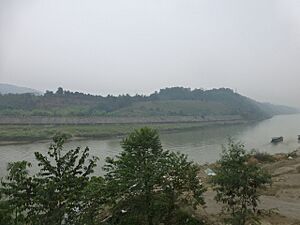Tonkin snub-nosed monkey facts for kids
Quick facts for kids Tonkin snub-nosed monkey |
|
|---|---|
 |
|
| Conservation status | |
| Scientific classification | |
| Genus: |
Rhinopithecus
|
| Species: |
avunculus
|
 |
|
| Tonkin snub-nosed langur range | |
The Tonkin snub-nosed monkey (Rhinopithecus avunculus) is a slim monkey that lives in trees. It is found only in northern Vietnam. This monkey has black and white fur, a pink nose and lips, and blue skin around its eyes. It lives high up in forests on rocky limestone mountains. These mountains are usually between 200 and 1200 meters (about 650 to 3,900 feet) above sea level.
Scientists first described this monkey in 1912. It was thought to be gone, but then rediscovered in 1989! It's still super rare. Of all five types of snub-nosed monkeys in the world, the Tonkin snub-nosed monkey is the rarest. In 2008, fewer than 250 were left. People are working hard to protect them. The biggest dangers to these monkeys are losing their homes and being hunted. Because of this, the International Union for Conservation of Nature says this monkey is "critically endangered". This means it's at a very high risk of disappearing forever.
Contents
What Does the Tonkin Snub-Nosed Monkey Look Like?
The Tonkin snub-nosed monkey has a flat face with a pink nose that points up. It also has thick pink lips and blue skin around its eyes. Its upper body is black, and its belly is creamy-white. There's an orange patch on its throat, which is brighter on males during breeding season. Its tail has a white tip.
From head to body, these monkeys are about 51 to 65 centimeters (20 to 26 inches) long. Their tails are even longer, from 66 to 92 centimeters (26 to 36 inches). Female monkeys weigh about 8 kilograms (18 pounds). Males are heavier, weighing about 14 kilograms (31 pounds). Young monkeys are grey instead of black and don't have the orange throat patch. Compared to other snub-nosed monkeys, the males and females of this species look more alike. They are also slimmer and have longer fingers and toes.
Life of the Tonkin Snub-Nosed Monkey
What Do They Eat?
The Tonkin snub-nosed monkey eats many different things. Their diet includes leaves, fruits, flowers, and seeds. They mostly eat leaves, especially from bamboo and evergreen trees.
These monkeys have strong jaws to chew tough plants. They also have a special stomach that helps them digest their plant-based food. Bacteria in their stomach break down plant parts, giving them more energy.
How Do They Reproduce?
The Tonkin snub-nosed monkey is a polygynous species. This means one male mates with several females. Females can have babies when they are about four years old. Males are ready to mate around seven years old.
After about 200 days of pregnancy, a female usually gives birth to one or two babies. Births often happen in the spring or summer. Scientists believe that female Tonkin snub-nosed monkeys are very caring mothers. This is based on how other snub-nosed monkey mothers act.
How Long Do They Live?
Most monkeys in the colobine family live for about twenty years. One colobine monkey lived to be twenty-nine years old in a zoo. The exact lifespan of Tonkin snub-nosed monkeys in the wild is not yet known.
Daily Behavior
Tonkin snub-nosed monkeys are diurnal. This means they are active during the day and sleep at night. They often sleep on lower tree branches near mountain slopes. This helps protect them from cold winds.
These monkeys move through the forest canopy in small groups. They usually live in an extended family group. This group includes an adult male, several females, and their young. The family often gathers to sleep and eat. However, it's becoming harder to see these family groups because their homes are shrinking and there are fewer monkeys.
Researchers have watched these monkeys closely. They spend about 40% of their day resting. About 10% is spent grooming each other. Around 23% of their time is spent watching for dangers. They spend about 3% of their day playing.
It's also been noticed that these monkeys don't always run away right away when humans appear. Instead, they start making loud, fast alarm calls. The main male of the group might even go towards the people. This behavior makes the Tonkin snub-nosed monkey more likely to be hunted.
Where Do They Live?
The Tonkin snub-nosed monkey lives in old-growth forests. These forests have bamboo and broadleaf evergreen trees. They are found at heights between 200 and 1200 meters (about 650 to 3,900 feet). Their homes are now limited to forests on hilltops and mountains made of karst limestone. Their environment also has monsoon rains and tropical temperatures.
What Is Their Role in Nature?
The Tonkin snub-nosed monkey plays a role in its environment similar to other plant-eating monkeys. They help spread seeds through their waste. This helps new plants grow and keeps the forest healthy.
Status of the Species
Since they were rediscovered, five separate groups of these monkeys have been found. Even though they are a "flagship species" (meaning they get a lot of attention for conservation), their numbers are still going down. Their home used to include areas east of Vietnam's Red River. Today, they are found in small areas in the Tuyen Quang, Bac Kan, Ha Giang, and Thai Nguyen provinces. The largest known group lives in the Khau Ca Species and Habitat Conservation Area in Ha Giang province.
Losing their homes and hunting are major reasons why these monkeys are disappearing. For many years, more and more people needed land for farming. This has caused the monkey's forest homes to shrink and break into smaller pieces. Their homes are also hurt by illegal logging (cutting down trees illegally) and sometimes mining. Mining can pollute the air and change their environment.
However, many of the monkey's homes were already lost or broken up before they were rediscovered. A study in 1993 in Na Hang Nature Reserve counted about 72 monkeys. A later study in 2005 at the same place found only 17 monkeys. This big drop in numbers over 13 years was mainly due to hunting.
Heavy poaching (illegal hunting) for food and the illegal wildlife market, along with habitat destruction, are why the Tonkin snub-nosed monkey is one of the most endangered primates. In 1993, hunting and trapping were common in Na Hang Nature Reserve. People hunted many animals, including the Tonkin snub-nosed monkey. The monkey was hunted for its meat, though it wasn't a favorite food. It was also hunted for special body parts. These parts, like its stomach or bones, were used to make traditional medicines. Local authorities worked to stop the hunting, but it increased again later. This happened because local people needed to find food and goods for new workers in their area.
Seeing these monkeys has become very rare. People thought they were extinct until the 1990s. That's when a small group was found in Na Hang District in Tuyen Quang Province. By 2008, when a small group with three baby monkeys was found, fewer than 250 of these primates were thought to exist.
In December 2013, Fauna and Flora International shared good news. A survey found between 108 and 113 monkeys in the Khau Ca Conservation Area. This was almost half of the estimated world population. It was also the highest number seen at that site since monitoring began. Researchers saw this as a hopeful sign that conservation efforts were helping. The latest survey in April 2017 found at least 113-121 monkeys in Khau Ca forest. This makes it the largest known population of Tonkin snub-nosed monkeys.
Working to Protect Them
Fauna & Flora International has been working hard to help the Tonkin snub-nosed monkey. To protect the two largest known groups, they are working with local communities. They help spread awareness about the monkeys and watch over their homes. Vietnamese authorities have also joined the effort to protect the Khau Ca forest. Since these efforts began, the monkey population there has grown and become more stable. While awareness about their danger is growing, more work is needed to keep them safe.
The Tonkin snub-nosed monkey is also listed in Appendix I of the Convention of International Trade in Endangered Species (CITES). This means it's protected by international law. Vietnamese law also forbids catching, killing, or trading this species. However, these laws are often ignored and hard to enforce.
Two other protected areas, Du Gia Nature Reserve and Cham Chu Nature Reserve, were also set up. They aim to protect the monkey population and its home in those areas. But hunting still happens in these "protected" places.
Conservationists say it's very important to involve local communities. They know that if local people struggle to make a living, they might not care as much about conservation. To help with this, conservationists are finding new ways to teach local people about the monkeys. They also help them with their lives. This includes offering training and jobs to local residents. Giving people a role in helping their environment and the Tonkin snub-nosed monkey can help ensure this critically endangered species has a chance to survive.
On July 21, 2022, Fauna & Flora International and the People's Committee of Ha Giang signed an agreement. They promised to work together to protect the Tonkin snub-nosed monkey and other plants in Ha Giang province from 2022-2027. They will study the monkeys' homes, behaviors, and populations. They will also help forests grow back, reduce human threats, use new technologies for conservation, and train people involved in protecting nature. This is a big step towards involving communities in saving the Tonkin snub-nosed monkey. The two groups will also find ways to fund forest conservation. This will involve working with communities and paying for services that help the environment.
|




